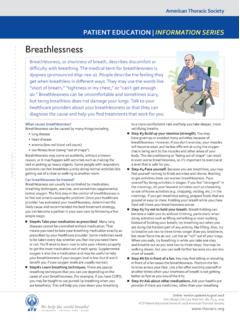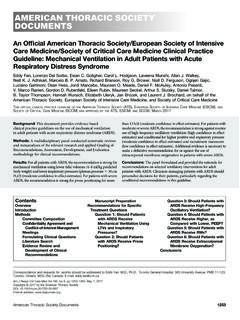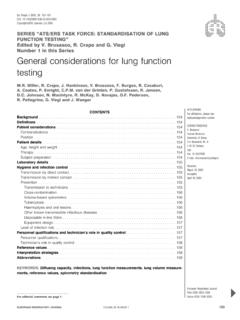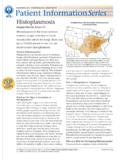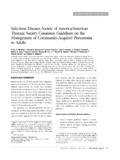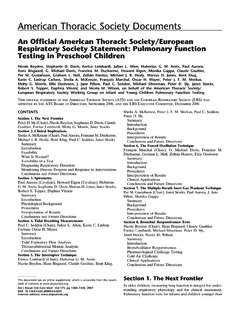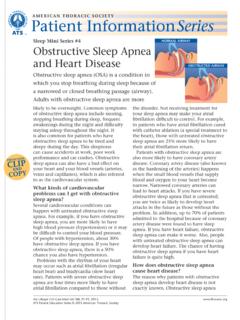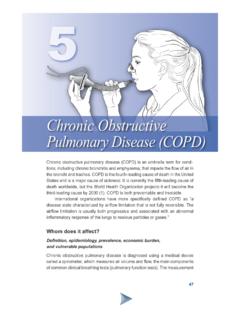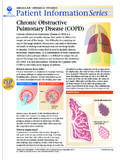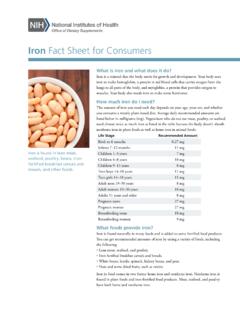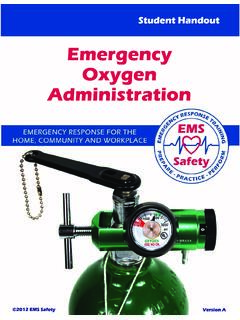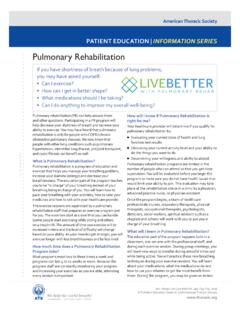Transcription of What Is Pulmonary Hypertension? - American Thoracic …
1 American Thoracic Society PATIENT EDUCATION | INFORMATION SERIES. PATIENT EDUCATION | INFORMATION SERIES. What Is Pulmonary hypertension ? Normal blood vessel Pulmonary hypertension (PH) is a general term that is used to Main Pulmonary artery (blood flows freely). describe high blood pressure in the lungs from any cause. This Blood is a different problem than high blood pressure in the whole Vessel body (systemic hypertension ). There are five different groups of Pulmonary hypertension that are based on the causes. Different Right Left Pulmonary hypertension atrium (blood flow is slow). types of PH can require different treatment but all forms of atrium Left Right Pulmonary hypertension are serious and can be life-threatening. ventricle ventricle Pulmonary hypertension can develop in children or adults at any age. This fact sheet will focus on adults and describe what happens in PH and groups.
2 For more information about Pulmonary hypertension in children and the diagnosis and treatment of Pulmonary hypertension see the Patient Information Series fact sheets at How does blood flow in the lungs? difficulty getting through the lungs to pick up oxygen , your To understand Pulmonary hypertension (PH) it helps to blood oxygen level may be lower than normal. This can put a understand how blood flows throughout your body. While the strain not only on your heart, but also decrease the amount of heart is one organ, it works like two pumps that are connected oxygen getting to your brain. These problems can lead to death. to one another. There is a left side and a right side of the heart, What are the different groups of Pulmonary each with two different jobs. CLIP AND COPY. hypertension ? The left side of the heart (left atrium) takes oxygen -rich blood There are 5 different groups, based on their causes: coming from your lungs and the left ventricle pumps this blood Group 1 Pulmonary arterial hypertension (PAH).
3 Throughout your body. Since the left side of your heart has to pump blood such a great distance, the left side of your heart is PAH differs from other forms of PH in that the artery walls in the designed to pump against a fairly high pressure. This pressure lungs are directly diseased. The arteries remodel and become is easily measured with a blood pressure cuff and is called your narrow, thick and/or stiff. There are several types of PAH: blood pressure. When your blood pressure is too high, it is called X Idiopathic PAH occurs without any clear cause systemic hypertension or simply, hypertension . X Hereditary PAH due to genes that are passed down After your blood has delivered oxygen to the tissues of your (inherited) in families X PAH occurring with other medical conditions including: body, the blood needs to come back to the lungs to get more oxygen . It does this by returning the blood to the right side of congenital heart disease the heart (right atrium) and then the right ventricle pumps the liver disease/cirrhosis blood into your lungs, so the process can start over again.
4 The HIV infection blood does not need to travel very far to get from the right side schistosomiaisis infection of your heart to your lungs. Therefore, the right side of your connective tissue diseases such as scleroderma and heart pumps against less pressure than the left side of your lupus heart. The right side of your heart is therefore normally a low- X PAH occurring with past or present drug use: pressure system. The pressure that the right side of your heart is use of prescription amphetamines or certain diet pills pumping against is called your Pulmonary pressure. use of illicit drugs such as cocaine and What happens in the lungs and body with PH? methamphetamines When the Pulmonary pressure is too high, it is called Pulmonary Group 2 Pulmonary hypertension due to left heart disease hypertension (PH). This puts stress on the right side of the heart When the left heart has problems that limit how well it can because the muscles on the right side are not used to pushing pump blood out to the body, it leads to a backup of blood in blood out to the lungs against such high pressures.
5 Over time, the lungs that raises pressure in the lungs. Group 2 is the most the right side of the heart is strained and begins to fail. common form of PH. The left heart can have problems with The heart can lose its ability to pump enough blood through weakened heart muscles that can't squeeze blood as well, stiff the lungs to meet the needs of the rest of the body. Blood gets heart muscles that can't relax normally, or with the valves on backed up into the veins of the lungs. Because the blood has the left side of the heart. Am J Respir Crit Care Med Vol. 203, P12-P13, 2021. ATS Patient Education Series 2021 American Thoracic Society American Thoracic Society PATIENT EDUCATION | INFORMATION SERIES. Group 3 Pulmonary hypertension due to lung disease out what kind of Pulmonary hypertension you have. There are This group includes PH due to chronic lung disease and/or treatments available which can stop it from getting worse and hypoxia (low oxygen levels).
6 Help At this time, there is no cure for most people This can occur in lung diseases like COPD, cystic fibrosis, and with PH. Centers specializing in PH ( interstitial lung disease. It can also occur with sleep apnea, Patients/FindADoctor) may be the best option for care as they particularly if not treated. It could also occur in a person who has have dedicated doctors, nurses, and other staff to assist in your been living in an area of high altitude for a long period of time care. because of the lower oxygen level in the air. Arteries in the lungs For more information about the diagnosis and treatment of tighten so that blood can only go to areas of the lungs that are Pulmonary hypertension , go to the ATS Patient Information receiving the most air and oxygen . Series fact sheet at GROUP 4 Pulmonary hypertension due to chronic blood clots in Author: Marianna Sockrider MD, DrPH. the lungs.
7 Original authors: Lisa Roessel FNP-BC, Karen A. Fagan MD, In this group, there are blood clots in the Pulmonary arteries Mark Gillespie PhD. that the body has trouble dissolving. These clots block blood Reviewers: Patrick Belvitch, MD, Anna Hemnes, MD, Parth Rali MD, flow in the lungs causing high blood pressures. This form of Tim Lahm, MD. Pulmonary hypertension is called chronic thromboembolic Pulmonary hypertension (CTEPH). For more information on CTEPH, see the ATS Patient information Series fact sheet at R Action Steps Talk to your healthcare provider if you have symptoms Group 5 Pulmonary hypertension due to unknown causes that might suggest Pulmonary hypertension In this group, PH is secondary to other diseases in ways that If you have chronic heart or lung disease work with your are not well understood. These associated conditions include, healthcare provider to keep it in good control to reduce but are not limited to, sarcoidosis, sickle cell anemia, chronic your risk of developing Pulmonary hypertension hemolytic anemia, splenectomy (spleen removal) and certain If you have other health issues that may lead to PH, ask metabolic disorders.
8 Your healthcare provider what to do and how to watch What are the symptoms of Pulmonary hypertension ? for any problems. There may be no signs or symptoms of PH in its early stages. If you have PH, work closely with a specialist in Over time, the high pressure in the lungs can put a stress on managing Pulmonary hypertension and take all the heart and low oxygen levels cause changes throughout the medications regularly. body. Some symptoms start out mild and get worse slowly while Healthcare Provider's Contact Number: others can come on all of a sudden. You can help your healthcare provider in diagnosing your condition by telling them what kind of symptoms you are having and if there is any worsening of these symptoms. For example, let your healthcare provider know if you notice any of For More Information the following: American Thoracic Society New or increased shortness of breath Dizziness COPD.
9 Feeling like you might faint CTEPH. Fainting/passing out (syncope) Diagnosis & Treatment of PH. Chest pain OSA in Adults Heart palpitations (feeling like your heart is racing or pounding) Pulmonary hypertension Association New or worsening swelling of your feet, legs or belly Lips and/or fingers turning blue PHAware Global Pulmonary hypertension (PH) can be difficult to diagnose in a routine medical exam because the most common symptoms PHA Europe European Pulmonary hypertension of PH, such as breathlessness, fatigue and dizziness, are also Association associated with many other conditions. If your healthcare provider suspects that you have PH, he or she will want to review your medical and family history, perform a physical exam US National Library of Medicine and perform one or more diagnostic tests. Because the different kinds of Pulmonary hypertension This information is a public service of the American Thoracic Society.
10 Are treated differently, it is important that your healthcare The content is for educational purposes only. It should not be used as a provider takes the time and orders the necessary tests to find substitute for the medical advice of one's healthcare provider.
